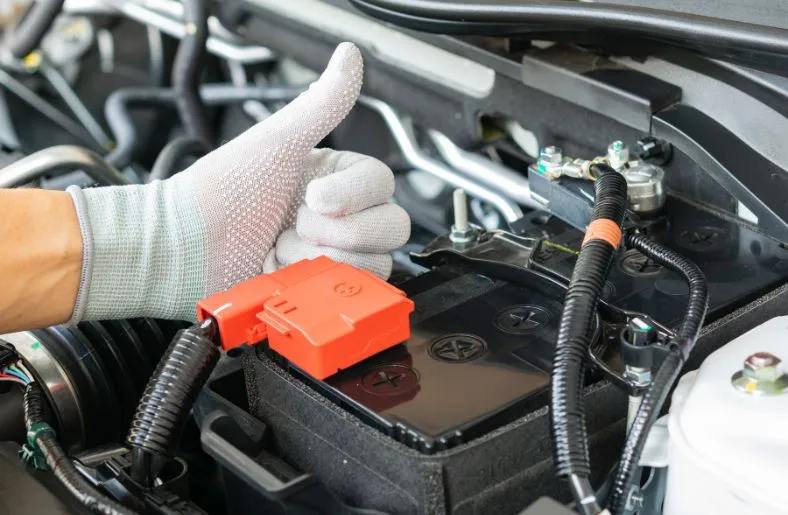Battery terminal corrosion is a common issue that many vehicle owners face. When corrosion occurs on the battery terminals, it can impede the flow of electricity, leading to poor performance and potential breakdowns. Understanding the causes of battery terminal corrosion is crucial to prevent it from happening in the first place.
In this comprehensive guide, I will delve into the various causes of battery terminal corrosion, its importance in maintaining optimal battery performance, and what to put on battery terminals to prevent corrosion.
Table of Contents
Causes of Battery Terminal Corrosion
A chemical reaction between the metal terminals and the sulfuric acid present in the battery primarily causes battery terminal corrosion. This reaction produces a white, powdery substance known as corrosion.
The main factors that contribute to this chemical reaction include exposure to moisture, high temperatures, and the presence of impurities in the battery acid. When these factors are present, the likelihood of corrosion forming on the battery terminals increases significantly.
Importance of Preventing Battery Terminal Corrosion
Preventing battery terminal corrosion is crucial for maintaining the overall performance and longevity of your vehicle’s battery. Corrosion on the battery terminals can lead to a poor electrical connection, which in turn affects the charging and discharging capabilities of the battery. This can result in decreased battery life, reduced starting power, and even complete battery failure.
Additionally, the presence of corrosion can hinder the proper functioning of electrical components in your vehicle, leading to potential malfunctions and costly repairs. By taking proactive measures to prevent battery terminal corrosion, you can avoid these issues and ensure that your vehicle’s battery operates at its best.
What to put on Battery Terminals to Prevent Corrosion
When it comes to preventing battery terminal corrosion, there are various products available on the market that can be applied to the terminals. These products are specifically designed to inhibit the chemical reaction between the battery acid and the metal terminals.
One commonly used product is petroleum jelly, which creates a barrier that prevents moisture and impurities from coming into contact with the terminals. Other options include specialized battery terminal sprays, coatings, and pads that provide a protective layer and prevent corrosion from forming.
So, what to put on battery terminals to prevent corrosion, choose such product that is compatible with your battery type, and follow the manufacturer’s instructions for application.
A Step-by-step Guide on Applying Anti-Corrosion Products to Battery Terminals
Applying anti-corrosion products to battery terminals is a relatively simple process that can be done at home with minimal tools. Here is a step-by-step guide on how to apply these products effectively:
- Start by disconnecting the negative terminal of the battery to avoid any electrical shocks or short circuits.
- Thoroughly clean the battery terminals using a mixture of baking soda and water. This will help remove any existing corrosion and ensure a clean surface for the anti-corrosion product.
- Rinse the terminals with clean water and dry them completely using a clean cloth or paper towel.
- Choose the anti-corrosion product that best suits your needs and apply it to the battery terminals according to the manufacturer’s instructions. Ensure that the product covers the entire terminal surface.
- Reconnect the battery by attaching the positive terminal first, followed by the negative terminal.
Related Guide: How to Clean Gun After Corrosive Ammo: A Comprehensive Guide? (2024)
How often should Anti-Corrosion Products be applied to Battery Terminals?
The frequency of applying anti-corrosion products to battery terminals depends on various factors, including the climate in which your vehicle operates and the type of anti-corrosion product used. As a general rule of thumb, it is recommended to inspect and clean the battery terminals every three to six months, or as needed.
If you notice any signs of corrosion or a decrease in battery performance, it is advisable to clean and reapply the anti-corrosion product more frequently. Regular maintenance and proactive measures will help ensure that your battery terminals remain corrosion-free and your vehicle operates optimally.
Conclusion
Preventing battery terminal corrosion is essential for maintaining the performance and longevity of your vehicle’s battery. By understanding the causes of corrosion and implementing preventive measures, such as regularly cleaning the terminals and knowing what to put on battery terminals to prevent corrosion, you can avoid issues related to poor electrical connections and potential breakdowns.
Always choose the right product for your battery type and follow the manufacturer’s instructions for application. Additionally, adopting good battery maintenance practices, such as keeping the battery clean and dry, will further contribute to preventing corrosion.

